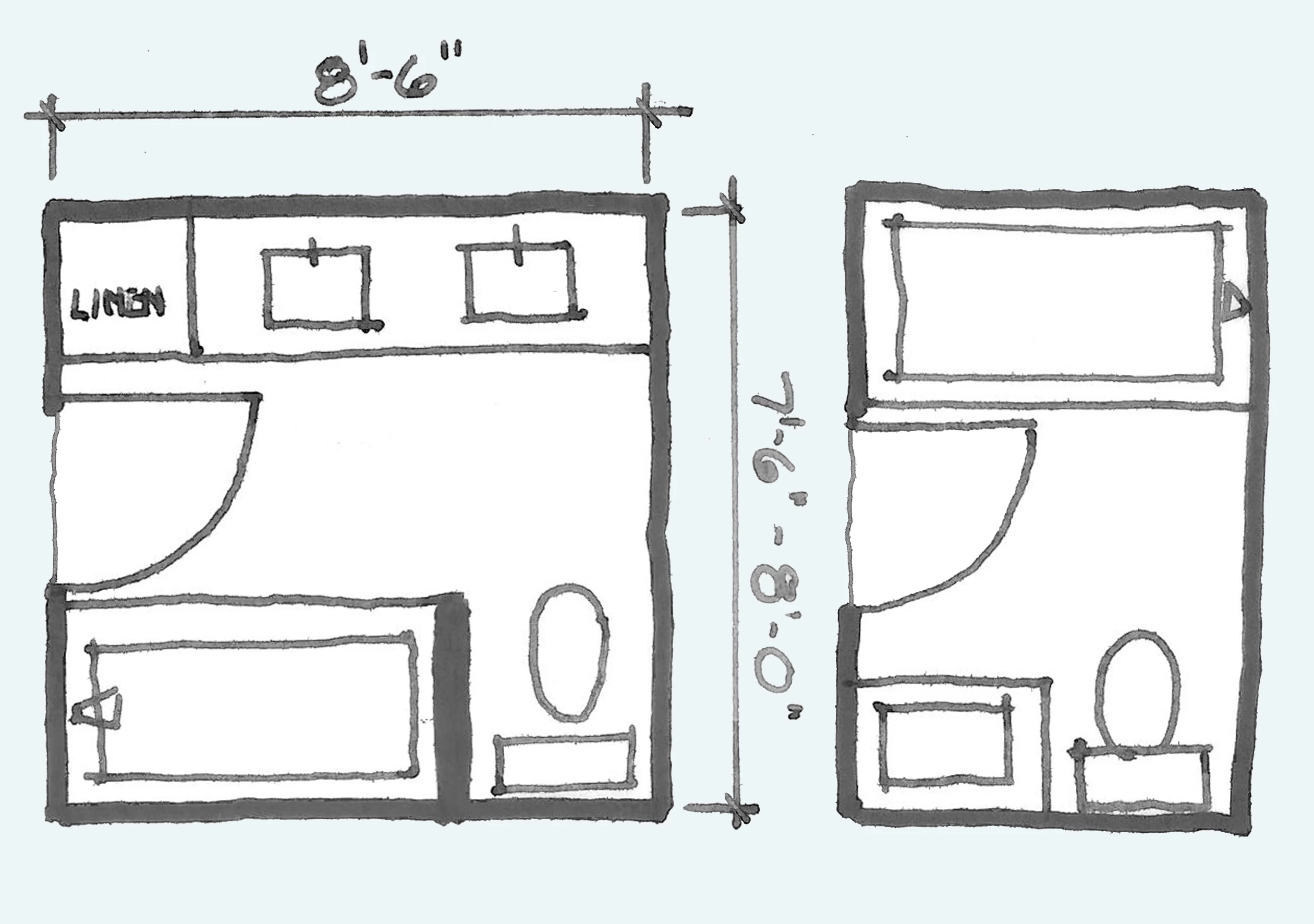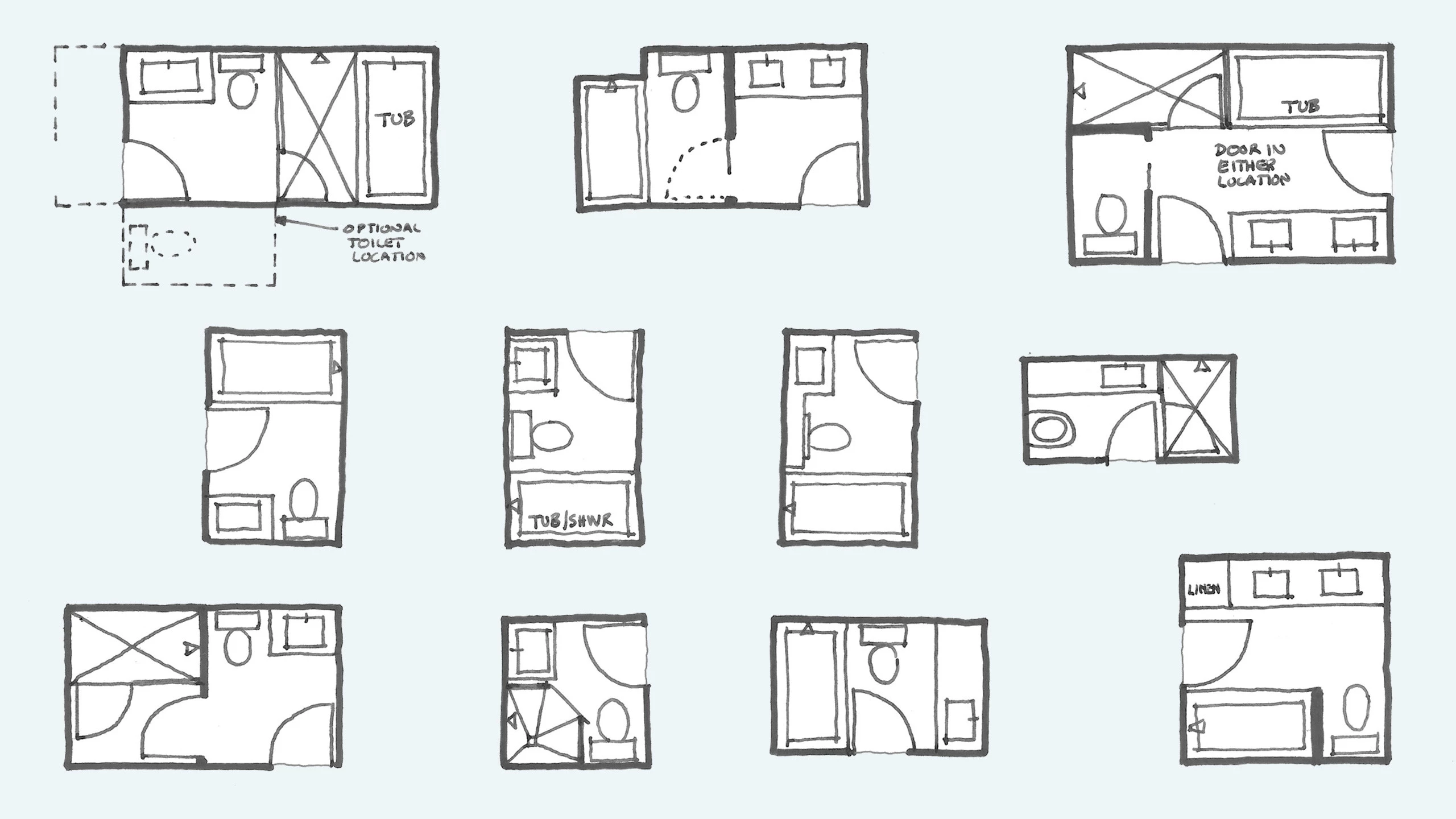Designing a Functional Layout: 8×11 Bathroom Floor Plans

Creating a functional and visually appealing layout for an 8×11 bathroom requires careful planning and consideration of the available space. This small footprint necessitates maximizing every inch while ensuring a comfortable and efficient flow.
Layout Options
The layout of a bathroom directly influences its functionality and aesthetic appeal. Several popular layouts can be adapted to fit an 8×11 bathroom, each offering unique advantages.
- Single-Vanity Layout: This layout features a single vanity along one wall, with the toilet and shower positioned on the opposite wall. This configuration is ideal for maximizing space and creating a sense of openness. It is particularly suitable for smaller bathrooms where minimizing clutter is paramount.
- Double-Vanity Layout: For larger 8×11 bathrooms, a double-vanity layout can be implemented. This layout involves placing two vanities along one wall, leaving ample space for the toilet and shower on the opposite wall. This layout provides extra counter space and storage, making it suitable for families or individuals who require more space for personal items.
- L-Shaped Layout: An L-shaped layout places the vanity and toilet on one wall, with the shower positioned in the corner to create a distinct, private space. This layout is ideal for creating a sense of separation between the different bathroom zones, making it suitable for bathrooms with limited space.
- Linear Layout: In a linear layout, all elements are placed along one wall, maximizing space and creating a clean, streamlined aesthetic. This layout is best suited for smaller bathrooms where maximizing space is a priority.
Maximizing Space
Optimizing space within an 8×11 bathroom is crucial for achieving a functional and aesthetically pleasing design. Several strategies can be employed to maximize the limited footprint.
- Compact Fixtures: Opting for compact fixtures, such as a pedestal sink or a corner shower, can save valuable floor space. Pedestal sinks eliminate the need for a vanity cabinet, freeing up floor space. Corner showers maximize space by utilizing the corner area efficiently.
- Vertical Storage: Utilizing vertical storage solutions, such as tall cabinets, shelves, and mirrors with storage compartments, maximizes space by utilizing the vertical dimension. This strategy helps to minimize clutter and create a more organized environment.
- Recessed Niches: Incorporating recessed niches in the shower wall can provide convenient storage for shampoo, soap, and other bathroom essentials, minimizing clutter on the shower floor.
- Floating Vanities: Floating vanities offer a sleek and modern aesthetic while maximizing floor space. They create a sense of openness and airiness, making the bathroom feel larger.
Creating a Sense of Flow, 8×11 bathroom floor plans
Creating a sense of flow within a bathroom is essential for ensuring a comfortable and efficient experience. This involves strategically positioning fixtures and furniture to promote smooth movement throughout the space.
- Open Layout: Opting for an open layout, where the shower, toilet, and vanity are not separated by walls, can create a sense of spaciousness and flow. This layout is ideal for smaller bathrooms where maximizing visual space is a priority.
- Wide Entryways: Ensuring wide entryways to the shower and toilet areas promotes easy access and movement within the bathroom. This is particularly important for smaller bathrooms where space is limited.
- Clear Pathways: Maintaining clear pathways between fixtures and furniture allows for comfortable movement throughout the bathroom. This can be achieved by strategically positioning furniture and fixtures to avoid obstructions.
Choosing the Right Fixtures and Materials

Selecting the right fixtures and materials is crucial for creating a functional and aesthetically pleasing bathroom in an 8×11 space. The choices you make will impact the overall look, feel, and functionality of the room.
Bathroom Fixtures for Small Spaces
Choosing the right fixtures for a small bathroom is essential for maximizing space and functionality. Here are some considerations:
- Compact Toilet: A compact toilet saves valuable floor space without sacrificing functionality. Look for models with a smaller footprint but a standard bowl size.
- Wall-Mounted Sink: A wall-mounted sink eliminates the need for a vanity cabinet, creating an open and airy feel. This design also allows for easier cleaning under the sink.
- Shower Stall: A shower stall is more space-efficient than a bathtub, especially in smaller bathrooms. Consider a corner shower stall to maximize space.
- Small-Sized Vanity: Choose a vanity with a smaller footprint to maximize floor space. Consider a floating vanity or a vanity with a built-in sink to save space.
- Space-Saving Storage Solutions: Maximize storage by incorporating shelving, cabinets, or a medicine cabinet to keep the bathroom organized and clutter-free.
Choosing the Right Materials
The materials you choose for your bathroom will affect its look, durability, and maintenance requirements. Here’s a breakdown of common bathroom materials:
Flooring Materials
- Ceramic Tile: Ceramic tile is a popular choice for bathroom floors due to its durability, water resistance, and wide range of styles and colors.
- Porcelain Tile: Porcelain tile is denser and more durable than ceramic tile, making it ideal for high-traffic areas. It is also more resistant to stains and scratches.
- Natural Stone: Natural stone, such as marble, granite, or slate, adds elegance and sophistication to a bathroom. However, it can be more expensive and require more maintenance than tile.
- Vinyl Plank: Vinyl plank flooring is a cost-effective and waterproof option that mimics the look of hardwood. It is easy to install and maintain.
- Luxury Vinyl Tile (LVT): LVT offers a wide range of styles and textures, including wood, stone, and tile. It is waterproof, durable, and easy to maintain.
Wall Materials
- Ceramic Tile: Ceramic tile is a versatile and durable option for bathroom walls. It comes in a wide range of colors, styles, and sizes, allowing for creative design possibilities.
- Porcelain Tile: Porcelain tile is a durable and water-resistant option for bathroom walls. It is also resistant to stains and scratches.
- Waterproof Paint: Waterproof paint is a cost-effective option for bathroom walls. It is easy to apply and maintain, but it may not be as durable as tile.
- Wainscoting: Wainscoting is a decorative paneling that adds a classic and elegant touch to bathroom walls. It is typically made of wood or a wood-look material and can be painted or stained to match the desired aesthetic.
Countertop Materials
- Granite: Granite is a durable and heat-resistant material that adds a luxurious touch to a bathroom. It comes in a wide range of colors and patterns.
- Marble: Marble is a classic and elegant material for countertops. It is known for its beauty and durability but can be more porous than other materials.
- Quartz: Quartz is an engineered stone that is durable, stain-resistant, and easy to maintain. It comes in a wide range of colors and patterns to match any style.
- Laminate: Laminate countertops are a cost-effective and durable option. They are available in a wide range of colors and patterns to match any style.
Creating a Cohesive Aesthetic
When designing a small bathroom, it’s essential to create a cohesive aesthetic that complements the space. Here are some tips:
- Use a Limited Color Palette: Stick to a limited color palette to avoid overwhelming the small space. Consider using neutral colors for the walls and flooring and adding pops of color with accessories.
- Choose a Light and Airy Color Scheme: Light and airy colors, such as white, cream, or pale blue, will make the bathroom feel larger and brighter.
- Maximize Natural Light: Maximize natural light by using a window or skylight. If natural light is limited, consider adding artificial lighting to brighten the space.
- Use Mirrors Strategically: Mirrors reflect light and create the illusion of more space. Place mirrors strategically to make the bathroom feel larger.
- Keep It Simple: Avoid cluttering the space with too many accessories or furniture. Keep the design simple and clean to create a sense of calm and spaciousness.
